Blogging Metrics: Apply Actionable Intelligence

Do blogging metrics really matter? Yes, they absolutely do. If the purpose of your content strategy is profit, customer acquisition or even brand awareness, it’s critical to apply regular analysis and take immediate action.
As Jay Baer points out, “without a statistical measure of your blogging process, adding content…can be an incredibly lonely proposition.” Unless you take a deep look into your traffic sources, page views and conversions on a consistent basis, you could find yourself at the helm of a blog that’s attracting the wrong type of visitors, or worse, just isn’t getting the attention you deserve.
Content creation and promotion are hard work, so make sure your efforts are paying off.
Why Do I Need Blogging Metrics?
There’s no shortage of statistics on website visitor behavior. In fact, as Google’s Digital Marketing Evangelist Avinash Kaushik jokes, “we have more web metrics and data than there are stars in the universe.” Unfortunately, that statement contains only a little bit of hyperbole. Modern marketing is tougher than ever, and big data could be your brand’s only hope for survival in a turbulent business climate. Leading Marketing Metrics firm McKinsey recently revealed two astonishing truths in Forbes:
- The total amount of available data increases 40% each year.
- Companies which use blogging metrics and analytics are, on average, 5-6% more profitable than their competitors.
A myriad of factors make content marketing and small business strategy significantly harder than it was a few years ago, including rapidly-changing technologies and consumer behavior. Web-based analytics are something of a floatation device for modern marketers. Learning how to utilize and apply blogging metrics in real-time will give you a significant advantage above your competition.
Which Blogging Metrics Should I Track?
Unfortunately, there’s no simple answer to this question. Few companies have sufficient staff to dedicate an individual solely to monitoring blogging metrics, which necessitates selecting a few key performance indicators to guide your strategy. Baer recommends first determining the overall goals of your content, and then selecting the metrics which offer the most actionable intelligence. We’ve outlined some of the most powerful analytics below, as well as offered insight on how to track them, and affect positive change:
1. Website Visitors
Perhaps the simplest among blogging metrics, page visits is a collective measure of all individuals who headed to your website during a given period of time. This figure is comprehensive, and does not account for people who visited your website multiple times, or include insight on how they found your blog. Page views are closely tied, and act as a measure of how many times each individual blog article and page on your website was engaged with.
As one of the most basic website metrics, there are a number of tools to determine your total website visits.
However, this information is the first blogging metrics listed on the Dashboard of Google Analytics:
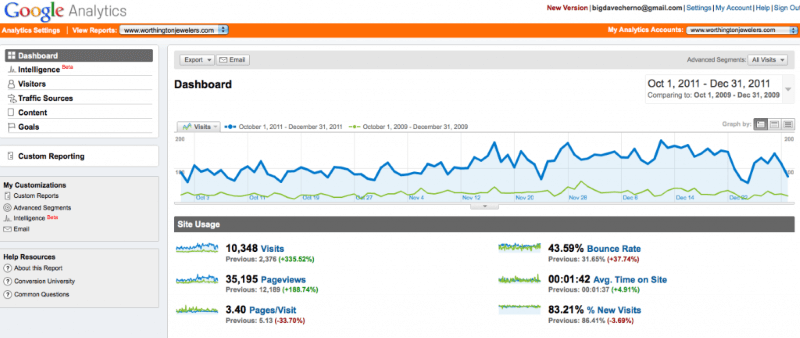
Image source: Sixth City
There are a number of ways to increase your total site visits each month, but the most effective tactic involves a blend of improvement and promotion, which could include the following actions:
- Build Website Authority: Utilize guest posting, quality content marketing, and regular site maintenance to win the respect of Google and other major search engines.
- Implement a Modern SEO Strategy: Utilize keyword research and optimization in moderation to ensure your content calendar is mapped to the topics which interest your prospects.
- Promote and Promote Again: Quality content isn’t always a surefire way to obtain positive SEO, particularly if your website is young, or you’re in a saturated niche.
- Emulate Success: Did your last article on chocolate cupcakes go viral, while your blog about baking techniques fizzled? Use page views to determine the topics which interest your readers, and emulate their success.
2. Pages per Visit
Do your website visitors feel satisfied after reading one of your articles, or are they hungry to learn more? Average pages per visit is a measure of crawl rate, the typical number of times a website visitor will continue clicking around your website. The higher this figure is, the better – blogging expert Wendy Piersall states that 3-4 pages viewed per visit is considered excellent.
Insight into average pages per visit is also conveniently located on the Dashboard of Google analytics. The correlation between quality and quantity of pages viewed is clear, but there are other ways to drive this metric up:
- Create Scannable Content: Research by Chartbeat has found that the average blog reader only consumes around 40% of a given article:
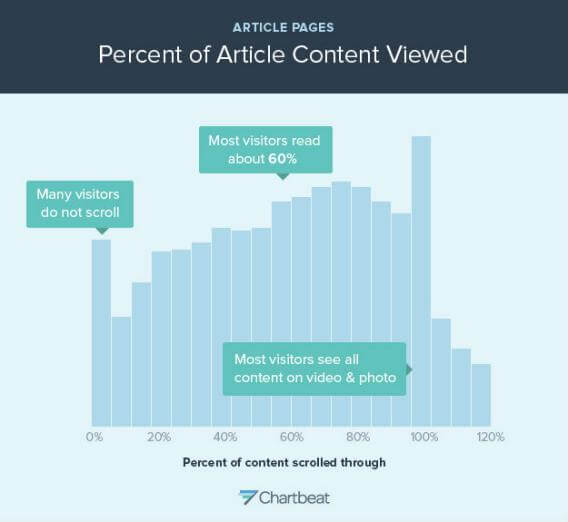
Image source: Chartbeat
Beating this statistic requires a dedication to creating visually-stimulating content that’s easy to read, which could include numbered lists, bullet points, and short paragraphs.
- Encourage Crawl Rate: Invite your readers to continue engaging by including call-to-action buttons, anchor text to relevant pages on your website, and a list of popular or recent posts in your sidebar.
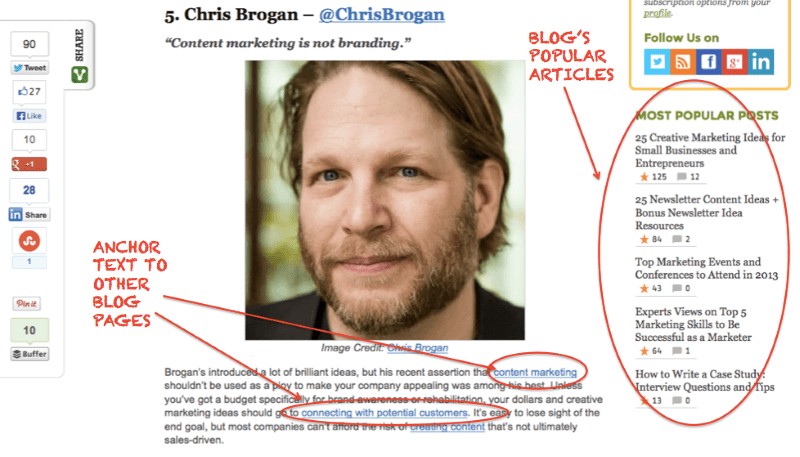
3. Bounce Rate
In an era where Twitter is positively saturated with content marketing, fabulous titles are key to standing out. However, taking the art of creative titling too far can contribute to one of the most dangerous blogging metrics, bounce rate. This is a measure of the number of people who leave your website without visiting a second page. Bounces most often occur when the content of a page isn’t what the visitor expected for one reason or another.
This intelligence is found on the dashboard of Google Analytics. To be fair, some bounce is natural, and if a figure is between 40-60% puts you in perfectly healthy territory. However, some SEO experts believe that excessive bounce rate can contribute to negative search rankings. Strive for titles which honestly reflect the content of your article, to avoid drawing visitors who are ultimately disappointed by your website.
4. Traffic Sources
Sorting your website visits by traffic sources can be among the most exhilarating steps towards leveraging the power of blogging metrics. This figure examines where your visitors come from, whether they found your website on a search engine or social media, allowing you to determine the relative strength of each component of your content promotion strategy:
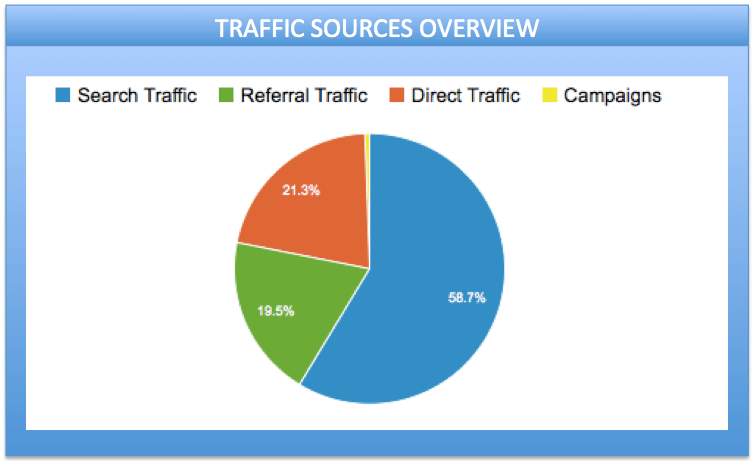
This insight can be found in most marketing metrics tools, including Google Analytics and HubSpot. The best blogging metrics platforms allow you to view sources in significant details, as well as view how percentages are trending over time. Use this intelligence to determine which areas of your content promotion strategy are working, and which need some help, as well as the specific social media networks which are driving the most traffic.
5. Traffic Location
Who should pay attention to blogging metrics about where their readers are located? Everyone, regardless of whether their company is locally-focused or not. Google Analytics allows users to view the location of their website visitors in both global and narrower focus, providing fascinating insights on just who your content is reaching:
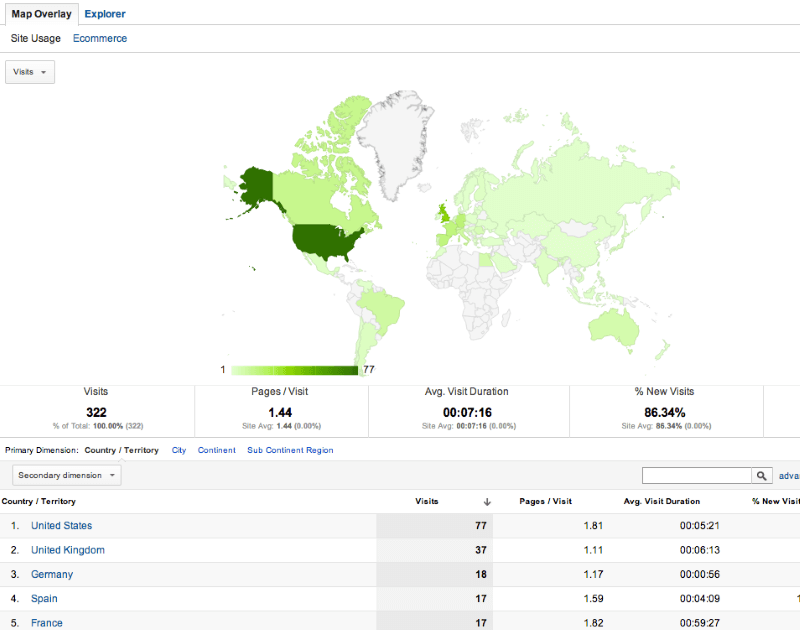
Image source: Optify
Your company’s goals will ultimately determine how you ought to apply insights on where your visitors are coming from, as well as how you use these blogging metrics to improve:
- Participate in Geo-Targeted SEO: If you find that you need to increase local visits, utilize Google’s keyword research tool to filter possible SEO opportunities by location.
- Optimize Your Content Marketing: To either broaden or narrow your focus, create content which includes either more or less relevance to global visitors.
6. Conversion Rate
When a first-time visitor lands on your website, what do they do? Are they willing to subscribe to your blog, or download an eBook? If you’re using blogging metrics to acquire leads or new customer acquisition, examination of your conversion rate, the total number of website visitors who provide you with their contact information, is crucial.
While some programs, including HubSpot and Marketo, automatically calculate your conversion rate, content marketers relying on more basic metrics tools will need to calculate conversions by hand, using the equation below:

While data can vary significantly according to a company’s industry, number of competitors, and marketing strategy, some studies have found that average conversions are somewhere between 3-8%. Conversions are a complex science of their own, but the following methods can allow anyone to increase their lead generation, regardless of whether or not they can code:
- Include More – and – Better Calls-to-Action: There is a serious art to designing a Call-to-Action (CTA) buttons which convert. Include a CTA on every page of your website to provide ample opportunity for conversions, and A/B test variations for optimal results.
- Ensure Your Website Is Trustworthy: Would you provide your contact information to a company with low-quality content, typos, or terrible web design? Probably not. The more professional you can make your content marketing, the better your chances of winning leads.
- Invest in Landing Pages: No matter how amazing your content is, you can’t generate leads without equally fantastic landing pages. Ensure your blogging metrics aren’t skewed by investing time, energy, and resources in pages which support your goals.
7. Backlinks
Inbound links to your content aren’t everything in SEO anymore, but they’re still incredibly important. Several years ago, search engines considered links a primary factor for determining the quality of content marketing. Experts believe this measure has shifted to include a virtually equal weight place on your content’s performance on social media networks. However, backlink profiles are one of the most essential blogging metrics.
In addition to Google Analytics and most major marketing automation platforms, you can easily check your blogging metrics with a free tool like Backlinks Watch or Majestic. This measure should be used to determine the quality and originality of your content marketing. If other bloggers and website owners in your niche view your site as trustworthy, you’ll win links and the respect of search engines. To generate more links utilize the following tactics:
- Become a Thought Leader: Prominence was almost never won through quality content alone. Take steps to establish authority by making time for guest posting, social media, and building relationships.
- Provide Value: Fresh statistics, original research, and controversial views can all serve as link bait for your website. Take time to ensure your content provides some value that simply can’t be found elsewhere online.
- Include Visual Content: Both infographics and video are SEO powerhouses, with some studies finding as much as 150% increase in inbound links with the addition of visual content.
8. Subscribers
Winning subscribers is a triumph. You’ve established sufficient trust in a website visitor that they’re willing to receive your outreach consistently. As Amanda Sibley of HubSpot points out, this segment allows you to “expand the top of your funnel,” and draw people back to your website consistently. Monitor this metric closely, and work closely to reexamine your efforts if you experience a significant drop in subscribers.
Most content management systems provide an easy method for monitoring subscribers, including WordPress and Blogger. While building your readership can be challenging, the following methods can positively influence one of the most important blogging metrics:
- Extend a Clear Invitation: Provide a highly visible subscribe widget on the sidebar of your blog to ensure your readers are aware they can receive communications regularly.
- Promote the Option to Subscribe: Do your email newsletter recipients know they can subscribe to your blog? What about your Facebook fans? Politely extend the invitation every so often.
- Include a Link in Bylines: When you guest blog on other websites, include a link directly to an option to subscribe to your blog to capture the interest of readers who found value in your post.
Blogging metrics can feel positively overwhelming to content marketers, many of whom are already struggling to balance the not-insignificant demands of quality content creation and promotion. However, defining key performance indicators for your content strategy, and performing continual analysis can give you a significant edge over less data-focused brands in your niche. Check your metrics often, and establish a content culture that’s ready to pivot based on data.
Are you monitoring blogging metrics? Which analytics do you examine on a consistent basis?

Comments (0)